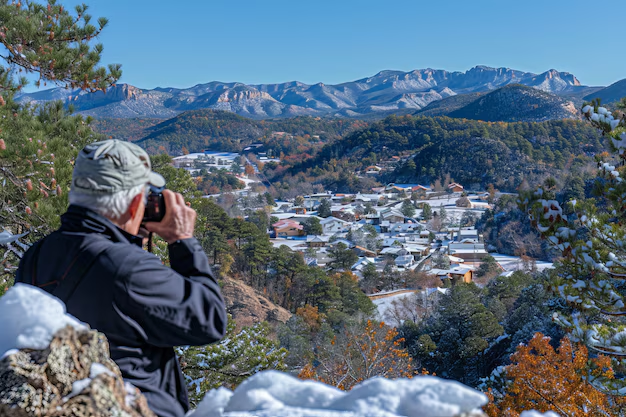Stewart Peak, a stunning landmark in Warner, NH, is more than just a mountain; it’s a tapestry of history and culture. From its Indigenous roots to the early settlers who named it, Stewart Peak has witnessed centuries of change. Each rock and tree tells a story, reflecting the lives of those who called this area home.
As you journey through this article, you’ll discover how Stewart Peak shaped the community, inspired legends, and became a hub for outdoor enthusiasts. Dive into the tales of climbers, conservation efforts, and the vibrant traditions that keep the spirit of Stewart Peak alive. Let’s uncover the rich history that makes this mountain a true treasure of Warner.
Table of Contents
Indigenous and Early Settler History
Stewart Peak has a rich history rooted in the lives of the Indigenous peoples who first inhabited the area. Long before European settlers arrived, Native Americans thrived on the land, relying on its resources for sustenance and shelter. They had a profound understanding of the local ecosystem, which shaped their way of life. The stories and traditions of these early inhabitants set the foundation for the cultural significance of Stewart Peak.
As settlers began to arrive in the late 17th century, they recognized the mountain’s potential. The naming of Stewart Peak can be traced back to one of these early pioneers. The exact origins of the name are intertwined with local folklore, but it is widely believed to honor a key figure in the community’s early development. This connection to the past reflects how integral Stewart Peak became to the identity of the growing town.
With the establishment of colonial settlements, the landscape around Stewart Peak underwent significant changes. Land grants were distributed, and agriculture flourished. Farmers began to cultivate the fertile soil, and small industries emerged, laying the groundwork for Warner’s development. The mountain not only served as a landmark but also as a resource for timber and other materials essential for building homes and businesses.
The arrival of European settlers also brought about challenges. Relationships between Indigenous peoples and newcomers varied, ranging from cooperation to conflict. As more settlers arrived, the dynamics of the region shifted, leading to cultural exchanges and tensions that would shape the future of Stewart Peak and its surroundings.
The history of Stewart Peak during this period reveals the complex interplay between the land and its people. It stands as a reminder of how communities evolve and adapt while holding on to the stories of their past. The mountain remains a symbol of resilience, reflecting the enduring spirit of thos
Stewart Peak Through the Centuries
Stewart Peak has witnessed significant transformations throughout the 18th and 19th centuries, shaping both the mountain itself and the surrounding community. During the 18th century, the peak served as a natural landmark for early settlers and Indigenous peoples. Its imposing presence provided direction and marked the landscape, becoming a part of local identity.

In the 19th century, Stewart Peak’s importance grew as the population in Warner expanded. As agriculture flourished, the mountain became a resource for timber and other natural materials. Logging operations began to take shape, which altered the forested areas around the peak. The timber industry became a major economic driver, supporting the local community while also leading to environmental changes.
The Civil War brought about a shift in the role of Stewart Peak. Many residents of Warner participated in the conflict, contributing to the larger narrative of national struggle. The mountain stood as a silent witness to their sacrifices and experiences. After the war, the peak became a place of reflection and remembrance, symbolizing the resilience of those who had fought for their beliefs.
Throughout the late 19th century, the peak continued to attract attention. Adventurers and climbers began to explore its trails, drawn by its beauty and the challenge it presented. This newfound interest in outdoor activities laid the groundwork for the recreational opportunities that Stewart Peak offers today. As the notion of leisure time grew in popularity, the mountain became a cherished destination for locals and visitors alike.
Culturally, Stewart Peak emerged as a focal point in local folklore and stories. As generations passed, legends about the mountain began to flourish, enriching the community’s narrative. These tales of adventure, exploration, and supernatural encounters fostered a deep connection between the residents and their natural surroundings.
By the end of the 19th century, Stewart Peak had established itself as a vital part of Warner’s heritage. It was no longer just a geographical feature; it had become a symbol of community spirit, adventure, and resilience. The history of Stewart Peak reflects the broader trends of American life during this time, showcasing the interplay between nature, culture, and human endeavor. As Warner continued to grow and evolve, the mountain remained a steadfast guardian of its past, present, and future.
Cultural Heritage and Folklore
Stewart Peak holds a special place in the cultural heritage of Warner, NH. Its imposing presence has inspired countless stories and legends that reflect the community’s identity and values. These tales often blend history with imagination, creating a rich tapestry of folklore that continues to be passed down through generations.
Local legends often feature the mountain as a central character, embodying the spirit of adventure and mystery. Stories of explorers and climbers recount their experiences on the trails, highlighting moments of triumph and camaraderie. These narratives foster a sense of connection among community members, as they share the thrill of conquering the peak and the beauty of the surrounding landscape.
The mountain also plays a role in the town’s traditions and cultural events. Seasonal festivals often take place in its shadow, celebrating local history and the changing seasons. Community gatherings allow residents to come together, sharing food, music, and stories, all while honoring the significance of Stewart Peak. These events reinforce a shared identity and promote a sense of belonging within the town.
Folklore surrounding Stewart Peak often intertwines with the stories of the Indigenous peoples who originally inhabited the area. Their traditions and beliefs contribute to the mountain’s cultural significance. Elders and storytellers play an important role in preserving these narratives, ensuring that the wisdom of the past remains alive in the hearts of the community.
The role of Stewart Peak in local myths also extends to the natural world. Many stories speak of the mountain’s unique wildlife and plants, attributing special meanings to various species. The beauty of the landscape becomes a source of inspiration, encouraging a sense of stewardship among residents. This connection to nature fosters a deeper appreciation for the environment and the need for its protection.
In addition to its stories, Stewart Peak serves as a reminder of the community’s resilience. Through challenges and triumphs, the mountain has been a steadfast companion to the people of Warner. The cultural heritage tied to Stewart Peak is not only a reflection of its history but also an expression of the values and aspirations of the community.
As Warner continues to grow, the stories of Stewart Peak remain a vital part of its identity. They enrich the lives of residents and visitors alike, offering a glimpse into the past while inspiring future generations to cherish and protect this remarkable natural landmark.
Environmental Stewardship and Conservation
Stewart Peak has been a focal point for environmental stewardship and conservation efforts in Warner, NH. As awareness of the need to protect natural resources has grown, so too has the commitment to preserve the mountain’s beauty and biodiversity.
The establishment of parks and protected areas around Stewart Peak marks a significant step toward conserving the landscape. Local organizations and state initiatives have collaborated to create guidelines that promote sustainable practices. These efforts aim to balance recreational activities with the preservation of the area’s natural habitats.
Logging played a major role in the early economy of Warner, but it also led to considerable changes in the environment. Recognizing the impact of deforestation, community leaders began advocating for responsible land use. This shift led to the implementation of stricter regulations on logging practices, promoting reforestation and habitat restoration.
As recreational activities gained popularity, the community recognized the importance of maintaining the trails and surrounding areas. Volunteers often come together for cleanup days and maintenance projects, ensuring that Stewart Peak remains accessible and enjoyable for all visitors. These community-driven efforts reflect a shared responsibility for the care of the mountain and its ecosystems.
Education also plays a vital role in conservation initiatives. Local schools and organizations often engage in programs that teach residents and visitors about the unique flora and fauna of Stewart Peak. Workshops, guided hikes, and informational signage help foster a deeper understanding of the environment, encouraging people to take an active role in its protection.
Climate change poses ongoing challenges to the mountain’s ecosystems. In response, conservation groups have been developing strategies to mitigate its effects. These include monitoring wildlife populations, studying changes in vegetation, and adapting management practices to address emerging threats. Such proactive measures are crucial for maintaining the health of the environment surrounding Stewart Peak.
The future of Stewart Peak relies heavily on the commitment of the community and local organizations. Collaborative efforts aimed at conservation and sustainability are key to preserving the mountain’s rich natural heritage. Through education, advocacy, and active participation, the residents of Warner continue to honor Stewart Peak as a cherished part of their landscape, ensuring its legacy for generations to come.
Modern-Day Stewart Peak
Today, Stewart Peak stands as a vibrant hub for outdoor recreation and tourism, attracting visitors from near and far. Its diverse offerings cater to adventurers, families, and nature enthusiasts alike. Hiking trails wind through scenic landscapes, providing breathtaking views and a chance to connect with nature. These trails vary in difficulty, making them accessible to both novice hikers and seasoned adventurers.

The peak’s popularity has led to an increase in organized events, including guided hikes and educational programs. Local organizations often host workshops that focus on the area’s ecology, promoting awareness and appreciation for the natural environment. These events not only highlight the beauty of Stewart Peak but also foster community engagement.
In addition to hiking, Stewart Peak offers opportunities for other outdoor activities. During winter months, the area transforms into a destination for snowshoeing and cross-country skiing. The mountain’s varied terrain provides an exciting playground for those looking to enjoy the snowy landscape. Families often gather for picnics and outings, taking advantage of the scenic spots that Stewart Peak offers year-round.
Tourism around Stewart Peak contributes to the local economy, benefiting small businesses in Warner. Restaurants, shops, and accommodations see an influx of visitors, particularly during peak seasons. The community has embraced this growth, often collaborating to create promotional materials that showcase the area’s natural beauty and recreational opportunities.
As interest in eco-tourism continues to rise, Stewart Peak is positioned to benefit from this trend. The commitment to environmental stewardship and sustainable practices resonates with travelers seeking authentic experiences in nature. The mountain serves as a model for balancing tourism and conservation, demonstrating that it is possible to enjoy the outdoors while protecting its integrity.
Stewart Peak’s modern identity reflects the ongoing relationship between the community and the land. It stands as a reminder of the importance of preserving natural spaces for future generations. By embracing both recreation and conservation, Warner continues to cultivate a deep connection to Stewart Peak, ensuring that it remains a cherished destination for years to come.
The Economic Impact of Tourism
The economic impact of tourism around Stewart Peak is substantial, contributing significantly to the local community in Warner, NH. As visitors flock to the area for its outdoor activities and natural beauty, local businesses thrive. Restaurants, shops, and lodging establishments experience increased patronage, which helps sustain the town’s economy.
The influx of tourists creates job opportunities in various sectors. Seasonal positions in hospitality and outdoor recreation become available, providing income for many residents. This boost in employment not only supports individuals and families but also helps cultivate a workforce that is knowledgeable about the local environment and culture.
Events centered around Stewart Peak also play a role in stimulating the economy. Community festivals, guided tours, and educational programs draw visitors eager to learn and explore. These events often involve local artisans, food vendors, and entertainers, further enhancing the economic benefits for the area. The synergy between tourism and community engagement fosters a vibrant atmosphere, attracting even more visitors each year.
Environmental conservation initiatives have also seen support from the tourism sector. Many visitors appreciate the town’s commitment to preserving natural spaces, and this shared value has encouraged donations and volunteer efforts toward local conservation projects. The collaboration between businesses and environmental organizations enhances the sustainability of the area, creating a more resilient ecosystem that benefits both nature and the economy.
However, the growth of tourism also presents challenges. Increased foot traffic on trails can lead to wear and tear on the natural environment, prompting the need for maintenance and conservation efforts. The community must balance the benefits of tourism with the responsibility of protecting Stewart Peak’s delicate ecosystems. Ongoing discussions among residents, business owners, and conservationists focus on sustainable practices that will allow tourism to thrive without compromising the integrity of the area.
In essence, the economic impact of tourism around Stewart Peak reflects a dynamic relationship between the community and its natural resources. By embracing sustainable tourism practices, Warner can continue to benefit from the mountain’s allure while preserving its rich heritage for future generations. The ongoing collaboration between tourism and conservation creates a promising outlook for both the economy and the environment surrounding Stewart Peak.
Community Engagement and Historical Preservation
The preservation of Stewart Peak’s rich history has always been deeply intertwined with community engagement. The people of Warner take pride in their local heritage, actively participating in efforts to preserve and celebrate the mountain’s significance. This involvement can be seen through the town’s various historical societies, volunteer groups, and public events that keep the spirit of the past alive.
Local historical societies play a key role in documenting and protecting the stories tied to Stewart Peak. Through archives, exhibits, and public talks, these organizations share the mountain’s history with residents and visitors alike. They collect photographs, oral histories, and documents that capture the evolution of Warner and the integral role Stewart Peak has played over the years. These efforts create a lasting record that future generations can access to understand the region’s development.
Community events further highlight this dedication to preservation. Seasonal festivals, historical reenactments, and guided tours of the area are organized by local groups, drawing attention to Warner’s unique past. These events often bring together residents, historians, and visitors who wish to learn more about the mountain’s role in shaping the town’s identity. The shared experience strengthens the bond between the community and its environment.
Volunteerism is another important aspect of community engagement. Residents of Warner often take part in conservation projects, trail maintenance, and educational programs focused on Stewart Peak. This hands-on involvement not only preserves the mountain’s physical landscape but also fosters a deeper connection between individuals and the land. Schools and community groups frequently organize clean-up efforts or educational workshops to instill an appreciation for Stewart Peak’s natural and historical significance.
In addition to these efforts, the town has made strides in promoting sustainable tourism practices to protect Stewart Peak from overuse while allowing visitors to appreciate its beauty and history. This careful balance between accessibility and preservation reflects the community’s commitment to ensuring the peak remains an asset for generations to come.
Through their involvement in historical preservation and environmental stewardship, the residents of Warner have made Stewart Peak more than just a landmark. It has become a symbol of their collective memory, a shared space where history, nature, and community come together. This sense of ownership and pride continues to fuel efforts to safeguard both the mountain’s legacy and the natural beauty that surrounds it.
Future Prospects for Stewart Peak
Looking ahead, the future of Stewart Peak remains intertwined with both community efforts and its natural environment. As the mountain continues to serve as a key attraction for visitors and a vital part of Warner’s identity, its long-term preservation and sustainable development will be paramount.

One of the most important factors influencing Stewart Peak’s future is environmental conservation. As climate patterns shift and human activity increases, there will be ongoing challenges in maintaining the health of the ecosystem. Local conservation groups and state authorities will likely continue their work to monitor wildlife, protect habitats, and maintain the quality of the natural environment around the peak. Expanding educational programs about conservation could also play a major role, encouraging the next generation to take an active part in stewardship.
Tourism will also shape the mountain’s future. The balance between welcoming visitors and protecting the landscape will require careful planning. As more people discover Stewart Peak, the need for infrastructure that supports responsible tourism, such as improved trails and visitor education centers, may increase. Local businesses will continue to benefit from the steady stream of visitors, but with that comes the responsibility of minimizing the impact on the environment.
Another key aspect of Stewart Peak’s future lies in the preservation of its historical and cultural significance. As time passes, it will be important for Warner’s residents to continue documenting and celebrating the stories connected to the mountain. Historical societies, educational institutions, and the wider community can work together to keep the peak’s rich history alive through events, archival work, and public engagement.
Modern technology may also play a role in both conservation and education. Digital resources, such as virtual tours and interactive apps, could offer ways for people to experience Stewart Peak without adding to physical foot traffic. Such innovations can help preserve the integrity of the landscape while still making its history and beauty accessible to a wider audience.
Stewart Peak’s future will be shaped by collaboration between local leaders, environmental groups, residents, and tourists. By maintaining a strong focus on sustainable practices and cultural preservation, Warner can continue to enjoy the benefits of this natural treasure while protecting it for future generations. The mountain will remain a symbol of resilience, connection, and the ongoing relationship between people and nature.
Conclusion
Stewart Peak stands as a remarkable testament to the intertwined histories of nature, community, and resilience in Warner, NH. Its towering presence has not only shaped the landscape but has also woven itself into the fabric of local culture and identity. From its Indigenous roots and early settler stories to its modern role as a hub for outdoor recreation and environmental stewardship, the mountain continues to inspire those who visit. As the community works together to preserve its heritage and protect its natural beauty, Stewart Peak will undoubtedly remain a cherished symbol of Warner’s past and future. The stories it holds, the adventures it offers, and the connections it fosters will resonate for generations to come, making it a true mountain of stories.
FAQ
- What is Stewart Peak?
- Stewart Peak is a prominent mountain located in Warner, New Hampshire, known for its natural beauty, recreational opportunities, and rich history.
- What outdoor activities can I enjoy at Stewart Peak?
- Visitors can enjoy hiking, snowshoeing, cross-country skiing, and picnicking. The area features a variety of trails suitable for different skill levels.
- Are there any guided tours available?
- Yes, local organizations often offer guided hikes and educational programs to help visitors learn about the mountain’s history and ecology.
- What is the history of Stewart Peak?
- Stewart Peak has a rich history that includes Indigenous roots, early European settlement, and its significance during events like the Revolutionary War and Civil War.
- How can I support conservation efforts at Stewart Peak?
- You can support conservation efforts by participating in volunteer programs, attending local events focused on environmental stewardship, and practicing responsible recreation by staying on designated trails.










